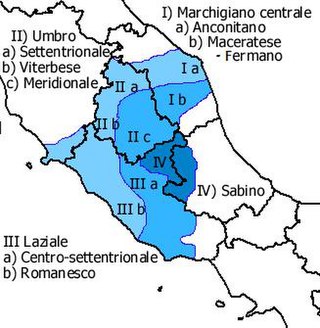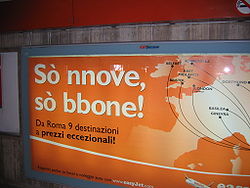This article needs additional citations for verification. (October 2007) |
Romanesco (Italian pronunciation: [romaˈnesko]) is one of the Central Italian dialects spoken in the Metropolitan City of Rome Capital, especially in the core city. It is linguistically close to Tuscan and Standard Italian, with some notable differences from these two. Rich in vivid expressions and sayings, Romanesco is used in a typical diglossic setting, mainly for informal/colloquial communication, with code-switching and translanguaging with the standard language.
| Romanesco | |
|---|---|
| Romano | |
| Native to | Italy |
| Region | Metropolitan City of Rome Capital, Lazio |
| Latin | |
| Language codes | |
| ISO 639-3 | – |
| Glottolog | None |
| Linguasphere | 51-AAA-rab |
 | |

History
editThe medieval Roman dialect belonged to the southern family of Italian dialects, and was thus much closer to the Neapolitan language than to the Florentine.[1][2] The 11th-century Saint Clement and Sisinnius inscription already has Romanesco features. A typical example of Romanesco of that period is Vita di Cola di Rienzo ("Life of Cola di Rienzo"), written by an anonymous Roman during the 14th century.[1] Starting with the 16th century, the Roman dialect underwent an increasingly stronger influence from the Tuscan dialect (from which modern Italian derives) starting with the reigns of the two Medici popes (Leo X and Clement VII) and with the Sack of Rome in 1527, two events which provoked a large immigration from Tuscany.[3][4] Therefore, current Romanesco has grammar and roots that are rather different from other dialects in Central Italy.[4]
The path towards a progressive Tuscanization of the dialect can be observed in the works of the major Romanesco writers and poets of the past two centuries: Giuseppe Gioachino Belli (1791–1863), whose sonetti romaneschi represent the most important work in this dialect and an eternal monument to 19th century Roman people; Cesare Pascarella (1858–1940); Giggi Zanazzo (1860–1911); and Carlo Alberto Salustri (1871–1950), nicknamed Trilussa.
Diffusion
editBefore Rome became the capital city of Italy, Romanesco was spoken only inside the walls of the city, while the little towns surrounding Rome had their own dialects. Nowadays, these dialects have been replaced with a variant of Romanesco, which therefore is now spoken in an area larger than the original one. It slightly pervades the everyday language of most of the immigrants who live in the large city.[citation needed]
Pronunciation
editRomanesco pronunciation and spelling differs from Standard Italian in these cases:
- /j/ (lengthened) is used where standard Italian uses [ʎ]. This [j] is spelt ⟨j⟩, a letter seldom used in present-day Italian. Compare Italian figlio [ˈfiʎʎo] "son" and Romanesco fijo [ˈfijːo];
- geminate /r/ ("rolled r" or alveolar trill) does not exist anymore: for example, azzurro [aˈdːzuːɾo]; (Italian: azzurro "light blue"), verrebbe [veˈɾebːe] (Italian: verrebbe "he/she would come").[5] A Roman pun recites: "Tera, chitara e guera, co' ddu' ere, sinnò è erore" (English: "Ground, guitar and war with two R's, otherwise there is a mistake"): ere and erore are also "wrong", as they are erre and errore in Standard Italian.[5] This phenomenon presumably developed after 1870, as it was not present in the classical 19th century Romanesco of Belli;[5]
- /l/ becomes /r/ before another consonant: sòrdi [ˈsɔɾdi], Italian soldi "money";
- in Romanesco, as in most Central and Southern Italian languages and dialects, /b/ and /dʒ/ are always geminated where permissible: e.g. libbro [ˈlibːɾo] for Standard Italian libro [ˈliːbro] "book", aggenda for agenda "diary, agenda".
- the dropping of vowels at the beginning of a word when followed by a nasal consonant (m, n, gn), for example 'nzomma (Standard Italian insomma), 'n (Standard Italian un/in), 'mparà (Standard Italian imparare), gni (Standard Italian ogni).[6]
- assimilation with different consonant groups. (typically a Central-Southern phenomenon) For example, /nd/ turns into /nn/ (Standard Italian quando turns into quanno), /ld/ turns into /ll/ (Standard Italian caldo turns into callo), /mb/ turns into /mm/ (Standard Italian piombo turns into piommo).
Quote
editMa nun c'è lingua come la romana |
But there is no language like the Roman one |
| —G. G. Belli, "Le lingue der monno" [Languages of the world][7] |
Noteworthy figures
editToday, Romanesco is generally considered more of a regional idiom than a true language. Classical Romanesco, which reached high literature with Giuseppe Gioachino Belli, has disappeared.
External forces such as immigration and the dominance of Italian are playing a role in the transformation.
Notable artists using Romanesco
editThis section of a biography of a living person needs additional citations for verification. (September 2014) |
- Ettore Petrolini, actor
- Elena Fabrizi, actor and cook
- Christian De Sica, actor and singer
- Antonello Venditti, singer
- Aldo Fabrizi, actor and director
- Alberto Sordi, actor and director
- Nino Manfredi, actor
- Anna Magnani, actress
- Enzo Salvi, actor
- Gabriella Ferri, singer
- Tomas Milian, actor
- Mario Brega, actor and comedian
- Gigi Proietti, actor, director and comedian
- Enrico Montesano, actor and comedian
- Carlo Verdone, actor and director
- Sabrina Ferilli, actress
- Trilussa, poet (Carlo Alberto Salustri's pen name)
- Giuseppe Gioacchino Belli, poet
- Cesare Pascarella, poet
- Lando Fiorini, actor and singer
- Franco Califano, lyricist, musician,
- Ferruccio Amendola, voice actor
- Paola Cortellesi, actress
- Zerocalcare, comics author
- The anonymous writers of the Pasquinades posted on the talking statues of Rome use Italian, Romanesco or a mixture of both.[8]
See also
edit- Belli's The Sovrans of the Old World (1831)
References
edit- ^ a b "La Parlata romana" (PDF). online.unistrasi.it (in Italian). Università per stranieri di Siena. Archived from the original (PDF) on 6 February 2015. Retrieved 6 February 2015.
- ^ "Romanesco". www.treccani.it (in Italian). Treccani. Retrieved 6 February 2015.
- ^ D'Achille, Paolo. "Italiano di Roma". www.treccani.it (in Italian). Treccani. Retrieved 6 February 2015.
- ^ a b "Dialetti". www.treccani.it (in Italian). Treccani. Retrieved 6 February 2015.
- ^ a b c Ravaro 2005, p. 26
- ^ Canepari, Luciano (1992). Manuale di pronuncia italiana: con un pronunciario di oltre 30000 voci e due audiocassette C45 (in Italian). Bologna: Zanichelli. ISBN 88-08-10888-0.
- ^ Belli, Giuseppe Gioachino (1965). Muscetta, Carlo; Lanza, Maria Teresa (eds.). I sonetti (in Italian). Milano: Feltrinelli. OCLC 459505006. Retrieved 31 March 2024.
- ^ Vidal, José Manuel (10 February 2017). "Pasquines contra Francisco, el Papa que atemoriza a los poderosos". Periodista Digital (in Spanish).
Sources
edit- Ravaro, Fernando (2005). Dizionario romanesco (in Italian). Roma: Newton Compton. ISBN 88-541-1792-7.
External links
edit- A description of the Roman dialect
- (in Italian) Lucio Felici, Le vicende del dialetto romanesco Archived 2012-02-20 at the Wayback Machine, in "Capitolium", 1972 (XLVII), n° 4, pp. 26–33 (it is a summary of the history of Romanesco from the origin to nowadays).